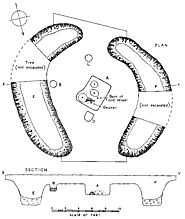|
|
|
|
Fargo Plantation HengeHenge
|
||||||||||||||||||||||||
|
|
|
Images (click to view fullsize) |
|

|
Miscellaneous |
|
|
Details of Henge on Pastscape A small Neolithic / Bronze Age hengiform enclosure, located within Fargo Plantation and one of the circular monuments known as the Cursus Barrow Group (Monument Number 219681). An irregular hollow, circa 8.5m in diameter, is recognisable at the approximate location of Stone's 1938 excavation, which found a ring ditch surrounding a levelled sub-circular area circa 6 metres by 4 metres which featured entrances or causeways at the northern and southern ends. There may originally have been an external bank. The enclosed central area contained a roughly central sub-rectangular grave pit containing an incomplete inhumation, although it is unclear whether or not the full skeleton was ever present. The inhumation seems to have been accompanied by a Beaker. Two further cremations in shallow holes dug into the floor of the pit, one possibly accompanied by a Food Vessel, seem to have been broadly contemporary. A third cremation had been inserted into the backfilled grave at a later date. A sherd of Peterborough Ware, a fragment of bluestone, and some antlers were recovered from the ditch. The earthworks were observed by English Heritage in November 2010 during a rapid field investigation (Level 1 survey) of Fargo South as part of the Stonehenge WHS Landscape Project. |
 Posted by Chance
Posted by Chance21st September 2012ce Edited 23rd September 2012ce |
|
This miniature version of a Class II henge was first discovered in 1937 through pieces of Peterborough ware. A couple of local boy scouts, investigating rabbit scrapes in Fargo plantation, had brought the sherds to the attention of J.F.S. Stone, who had been working in the area for a number of years. Although no surface features where visible, it was decided to excavate the site, which was found to be about a metre below the present surface. A small sub-oval enclosure, approx. 30 ft. in diameter and markedly asymmetrical in outline, was uncovered, with causeways in the north and south. The northern one being much wider than the southern one. No surviving traces of a bank were found, although Stone interpreted the ditch sections as indicating an outside bank. Within the central area of the henge, a pit had been dug and lined with turfs. This contained part of a burial (the spine and ribcage of a young male, minus the head, arms, pelvis and legs), together with a beaker and base of a food vessel. Two cremations where also placed next to this burial. A third cremation was uncovered in the north-east corner and to the east of the central grave, another pit had been dug which contained a cist and a further cremation, both considered to be secondary to the original burial. The ditch silting contained an unaccompanied cremation in the upper part, a shard of Late Neolithic Mortlake ware, and a piece of Stonehenge rhyolite (Bluestone). Antler fragments were also recovered from the primary ditch silts, together with flint flakes and four flint scrapers. The stated dimensions of the henge were: Internal diameter ranged from c.3.96-6.10m, with the ditch width 1.52-1.68 m. Orientation is NNE, SSW See the enclosed plan/section for a clearer picture of this site |
 Posted by Chance
Posted by Chance14th November 2009ce Edited 14th November 2009ce |

